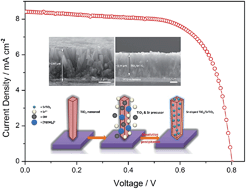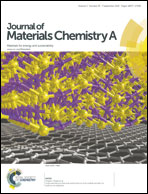Enhanced photovoltaic performance of dye-sensitized solar cells based on Sr-doped TiO2/SrTiO3 nanorod array heterostructures†
Abstract
We present a novel Sr-doped TiO2/SrTiO3 nanorod array heterostructure for dye-sensitized solar cells (DSSCs) via a facile two-step hydrothermal process, with a tunable microstructure, optical response and photoelectrical conversion properties. The chemical composition components and microstructures of Sr-doped TiO2/SrTiO3 nanorod array heterostructures are investigated using XRD, XPS, SEM and TEM characterization techniques, respectively. It is shown that the treatment of rutile TiO2 nanorod arrays in Sr(NO3)2 solution results in the self-doping of Sr into the lattice of TiO2 and formation of Sr-doped TiO2/SrTiO3 nanorod array heterostructures, inducing a transition of optical response properties from the ultraviolet region to the visible region. The photogenerated electrons and holes can be effectively separated due to the formation of SrTiO3/Sr-doped TiO2 heterostructures with a uniquely matched band-gap energy structure, resulting in greatly enhanced photoelectric conversion efficiency performance. Electrochemical impedance spectroscopy and photoluminescence results show that the formation of Sr-doped TiO2/SrTiO3 heterostructures can effectively prolong the charge carrier lifetime. The dye loading capacity on the Sr-doped TiO2/SrTiO3 heterostructures can be improved through the functionalization bonding of the hydroxide group on the surface of the electrode material. DSSCs based on the optimized Sr-doped TiO2/SrTiO3 heterostructure photoanode achieve the highest energy conversion efficiency of 4.70% (one sun illumination), nearly 1.5 times higher than the bare rutile TiO2 photoanode (3.10%).


 Please wait while we load your content...
Please wait while we load your content...